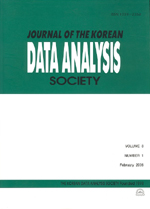협업필터링에서 사전평가 방법을 이용한 이웃선정의 예측 성능 개선
Improved Prediction Performance of Collaborative Filtering Based on Neighbor Selection by Pre-evaluation
- 한국자료분석학회
- Journal of The Korean Data Analysis Society (JKDAS)
- Vol.17 No.6
-
2015.123083 - 3095 (13 pages)
- 2

추천시스템은 전자상거래가 활성화됨에 따라 자동적으로 고객에게 필요한 상품을 찾아 추천하는 개인화시스템으로, 강력한 마케팅 도구로 부상하였다. 협업필터링 방법은 이미 전자상거래의 여러 분야에서 성공적으로 적용되고 있는 추천기법이다. 그러나 고객과 거래상품이 증가함에 따라 보다 효율적으로 예측 정확도를 향상시키는 방법이 필요하게 되었다. 본 연구에서는 고객이 평가한 선호도의 기초 통계량으로 선호도 예측 이전에 이웃을 선정하여 예측 정확도를 향상시키는 방법을 제안하고 있다. 이를 위해 MovieLens 100K dataset과 1million dataset을 이용하여 예측 정확도 향상을 분석하였으며 일반적으로 data분할 방식으로 평가하는 예측 성과 평가 방법을 전체 data를 이용하는 방법을 이용하여 평가하였다. 또한 예측 성능을 전체 시스템의 성과분석이 아닌 평가자 개인별 MAE를 이용하여 예측 정확도의 향상을 통계적으로 분석하였다. 분석결과에서 선호도의 평균이 작고 표준편차가 큰 이웃을 선정하여 선호도를 예측할 경우, 개인별 예측 정확도가 낮은 선호도의 표준편차가 큰 집단에서 예측 정확도를 향상시켜 사전평가 방법을 통한 이웃선정 방법이 선호도 예측 정확도 향상을 위해 효율적인 방법임을 제시하였다.
Collaborative filtering recommending approaches are successfully applied into diverse e-commerce fields for years. As the numbers of customer and traded goods increase, recommender systems need better ways to improve prediction accuracy more efficiently and effectively. In this study, we proposes a method for improving prediction accuracy of collaborative filtering based on neighbor selections those are evaluated basic statistics of customers’ preferences before prediction steps. In order to analyze improved our results, MovieLens 100K dataset and 1million dataset are used. Generally, prediction performance of collaborative filtering is assessed by data partitioning method. But, we assesses performance using the whole data of each dataset. Also, our research evaluate prediction performance of each user’s MAE by statistical test, not for whole system’s performance. In our test, it has better results in the group of users who have relatively lower standard deviation, this group has relatively lower performance, in case of selecting neighbors who have relatively lower mean of their preferences and also have higher standard deviation of their preferences. As a result, proposed neighbor selection methods using their basic statistics before prediction steps are more effective and efficient for improving prediction accuracy than before.
1. 서론
2. 이론적 배경
3. 실험방법
4. 실험결과
5. 결론
References
(0)
(0)